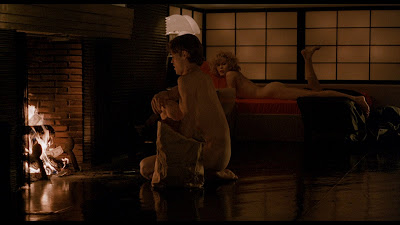
I decided to watch this hoping for some light and unchallenging '80s fun. The opening credits' style amused me and then I was informed that the soundtrack is by the band Wang Chung. 'Oh, yes,' thought I, 'this will certainly be goofy fun, at least.' The opening titles included the expected shots of smog-ridden LA, but also odd moments of women dancers

baring new-wave/tribal face paint in a slightly erotic manner. 'Excellent,' thought I, 'the 80's in LA possessed such a strange style. How marvelous!'
On a more serious level, I was curious about the performances of Willem Dafoe and John Tuturrow as the bad guys and the director, William Friedkin, who hasn't made a very good film since this, but who, in the '70s, directed 'The French Connection' and 'The Exorcist'.
The plot doesn't distinguish itself until the last half hour, following a base-jumping 80's Secret Service agent, played by William Petersen,

whose partner gets murdered investigating a counter-fitter, played by Dafoe. Dafoe plays an artist who lives in a fancy post-modern home with his nearly naked, exotic dancer girlfriend where he burns his other creations, oil paintings, if he doesn't approve of them. He's some oil-painting sociopath who makes a mean faux greenback.

Not much of a villain, but then Petersen isn't much of a hero. He's a protagonist, for sure. He's determined to avenge his partner's murder and he uses his lover/confidential-informant to get information to catch him in a sting, while threatening her to have her probation revoked. Real classy. So he comes off like a scum-bag with contemporary eyes, but then the plot thickens. His determination to catch Dafoe leads him to wrangle his new partner, a young and seemingly-noble John Pankow, best known as Pauly's best friend, Ira, on 'Mad About You'. They can't get enough money from the secret service to make a buy from Dafoe so they decide to hold up a diamond smuggler and
***SPOILER ALERT*** inadvertently kill an FBI agent. The chase following the murder is fantastic and makes the movie worth watching on its own. Pankow starts breaking down and is totally freaking out because not only has his crazy-thrill-junkie partner gotten him to rob a diamond smuggler and use the stolen money to make an unauthorized buy from a counterfeiter but he has murdered an FBI agent. Upon attempting to make the final buy and arrest Dafoe a serious plot twist threw my mind into a tail spin. This twist is actually so good, I won't say any more. I've probably said too much already. You should see the movie.
***

I'm so surprised by this plot twist. I was enjoying the strange world created by the film. It took some suspension of disbelief, but I was enjoying the Wang Chung and Petersen's athletic careening through LA. But the twist made me sit up and pay attention. And then, in a major crisis of traditional plot, a beautiful and glorious scene emerges, full of fire and moral confusion. The film truly captures and relates the Film Noir crisis of moral ambiguity into a universal setting.
***SPOILER ALERT*** Instead of being lured into the darkness by a criminal mastermind or a beautiful, sexy woman, nor by accident or fate, the tragic hero is lured there by an arrogant, confident, handsome epic hero who sweeps poor Pankow up in his scheme for glory, vengeance and just order. And then he is face to face with Dafoe amidst his burning art studio. Engulfed by flames, Dafoe asks Pankow why he didn't try to stop Petersen when he knew it had already gone much too far. 'Because you couldn't turn in your partner.' Pankow is distracted by his moral crisis and the flames leaping about them. and Dafoe beats him to the ground. Just as Dafoe is about to set him on fire with the shredded counterfeit money, Pankow shoots him and he's engulfed by flames.
The film ends with Dafoe's attorney watching home sex movies of Dafoe and his girlfriend. This girlfriend leaves with her new girlfriend, another exotic dancer from the club, played by 'Frasier''s Jane Leeves.

Pankow goes to Petersen's lover's apartment and accuses her of setting them up to kill the FBI agent. He tells her that she's working for him now. She flashes to thinking of sex with Petersen and then cue the Wang Chung and credits rolling over industrial LA at sunset.
***
Much of the movie is clumsy and flat, but the plot twist alone makes this well worth watching. The '80s fun cushions the stilted acting, plodding procedural scenes and the totally pointless plot line with Tuturro. Petersen is great fun playing this agent with unrestrained machismo, contrary to his fairly similar role in Michael Mann's 'Manhunter' from the following year.

And while this movie has an interesting moral core, it is still a bit ridiculous with contemporary eyes. The female characters are mannequins roaming about with the lure of sex trailing from their emaciated limbs. They are as relevant to the plot as the furniture. A group of black gangster associates of Dafoes are absurd stereotypes and four of these muscular thugs are defeated in hand-to-hand combat by a painter (Dafoe) and one other white dude in a puffy green army jacket that reminds me of neo-nazis. Stupid. And it's oddly gory. Several people get shot in the head and each time the film cuts to a quick close-up of their head, center screen, with a bullet hole in their face. Kind of fun, but it tells you the maturity level the film is aiming for. Then again, no one is watching this movie to see respectful portrayals of anyone. Watch it for the kitsch and the noir fun of the myth of LA in the '80s.





